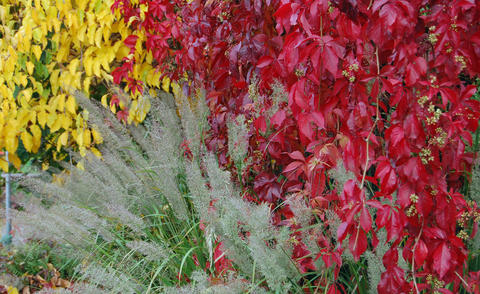American ivy, self-climbing Virginia creeper
The American ivy catches our attention in fall with its wonderful leaf colors. This is how you plant and care for the vigorously growing creeper.
Factsheet
- Growth type
-
- Climber
- Growth height (from)
- from 1000 cm to 2000 cm
- Growth characteristics
-
- Tendrils
- adhesive disks
- Flower color
-
- white
- Flowering time (month)
-
- July to August
- Flower shape
-
- panicles
- Flower characteristics
-
- unimpressive
- Leaf color
-
- green
- page format
-
- elliptiques
- finger-shaped
- narrow ovate
- Sheet properties
-
- Autumn coloring
- Fruit color
-
- blue
- Fruit shape
-
- Berry
- Light
-
- sunny to semi-shade
- Soil type
-
- sandy to loamy
- Soil Moisture
-
- fresh to moderately humid
- ph value
-
- alkaline to neutral
- Lime compatibility
-
- lime-tolerant
- Nutrient requirements
-
- nutrient-rich
- Decorative or utility value
-
- Leaf ornaments
- picturesque growth
- Nectar or pollen plant
- Toxicity
-
- non-toxic
- Winter Hardness
-
- hardy
- Climate zones according to USDA
-
- 5
- Use
-
- Garden fences
- Planters
- privacy screen
- Wall greening
- Garden style
-
- cottage garden
- natural garden
- Park area
- Pot garden
- Forest Garden
- Bee Friendly
- bee friendly plant
The American ivy (Parthenocissus quinquefolia), also known as self-climbing Virginia creeper, which is long living and probably the most popular creeper here. It covers walls and masonry with a thick carpet of its decorative foliage. The American ivy is native to eastern North America, where it is often seen covering trees at the forest edges. Botanically, the species belongs to the genus of the American ivy Virginia creeper (Parthenocissus) in the vine family (Vitaceae).
The deciduous climbing shrub is one of the self-climbers that can climb up without any additional help. If the young tendrils comes in contact with a wall or tree bark, for example, they attach themselves with the help of adhesive discs. This is how the American ivy spreads rapidly: Annually, it grows anywhere from 23.62 inches to 39.37 inches, so that over time, it can grow up to 49.21 to und 65.61 feet high.
The self-climbing Virginia creeperowes its botanical name affix "quinquefolia" to its five-part leaves. The leaves are alternately arranged and elliptical to long ovate. Often, the fresh green leaves assume their trademark fall colors from September onwards: The play of colors ranges from yellow to orange to a strong scarlet red.
In July and August, the inconspicuous, whitish flowers of the American ivy bloom in terminal panicles. They are fragrant and offer — especially in urban areas — a valuable source of nectar for bees and other insects.
The spherical fruits of Parthenocissus quinquefolia develop in late summer. The approximately 0.23 inch thick, blue-black and slightly frosted berries are eaten by birds. For us humans, however, they are not edible.
Even if the fall colors of the American ivy is most intense in a sunny place: There is hardly any place they can’t cope with. It thrives both in the sunny and (semi-)shady places. Moreover, it is immune to dry and dusty city air. Watch out for locations with strong winds: Then it is better to go for the American ivy ”Engelmanii”, since it forms stronger adhesive discs.
Both sandy soils and loamy soils are not a problem for the Parthenocissus quinquefolia. Ideally, the fresh to moist soil should be deep, loose and permeable — so as to avoid harmful waterlogging.
If you wish to plant the self-climbing virginia creepers for greening a facade, then you must plant several of them in spring or early summer at a distance of approximately 13.12 feet. As opposed to other climbers such as the Clematis the American ivy can make do without a climbing aid. At the beginning, however, the species that does not cling so well to any surface should be guided a little better, for example with the help of bamboo sticks. If planting in a container, the container volume should be at least 30 liters and the climbing frame should be well anchored.
In general, the American ivy requires at least one season to take root. To speed up its growth, you can add mature compost in spring.
Parthenocissus quinquefolia can be pruned best immediately after planting. This allows the climbing bush to branch well from below. Otherwise, cutting is not a must. In order to keep its growth in check on house facades around windows or gutters, it can be cut back regularly.
The American ivy is very hardy, but as a precaution, you can protect it in the first winter season.

The robust climber can be planted wherever you require masonry, facades, fences or even trellis to be quickly greened. With its decorative leaves, the American ivy also makes for an attractive sun shade and a privacy screen near a seating place. Its shoots hang down several feet, like dense garlands from old trees and wall tops. If it does not find any support, it can also spread out flat over the ground and hide large, bare areas under a carpet. The self-climbing Virginia creepers, planted in a pot or container, look good even on a patio.
An especially robust and popular variety is the Parthenocissus quinquefolia “Engelmannii”. In comparison to the species, it forms strong adhesive discs, hence, it is quite common nowadays. In fall, its delicate leaves are even more intense in color.
Typically, it can be propagated by hardwood cuttings or cuttings. The American ivy can also be propagated by sowing, immediately after the fruits ripen in September or October.
The self-climbing Virginia creeper is extremely robust and hardly suffers any plant diseases. Occasionally, however, voles can cause damage because they like to feed on the soft, fleshy roots.
